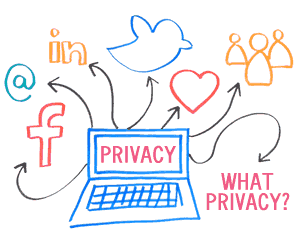
The Opinion Pages
December 2017
Are you safe on social media even with privacy settings?

INTRODUCTION
In today’s world, social media use has become extremely prevalent. It has become a way to connect with old friends, create new friends, and express yourself online. As social media has become more common, it has also become a source of danger if not used properly. Privacy settings have been put in place to help protect the users of these services.
Debaters
Privacy Settings are Not Fully Protective
MORGAN MCGRATH, KINESIOLOGY STUDENT AT LONGWOOD UNIVERSITY.
Updated December 29, 2017.
Social media has become very popular among teens, adolescents, adults, and even younger children in today’s world. Privacy settings are used within each site to help the user have control over who views and interacts with them on their profiles. Many people are under the impression that they are safe while using social media websites because of these privacy settings, but are you fully protected at all times?
Facebook is a social networking site where people “friend” one another and can share statuses, pictures/videos, check into various locations, update your personal profile, and even chat online. Twitter is a site that allows users to post and interact with their followers through likes and retweets. Instagram allows users to post pictures and videos to their followers. Snapchat is a social media where users can send or post pictures and videos to their friends or on their story for all their followers to view. On snapchat, a post “disappears” after a certain amount of time and is no longer visible to followers.
Many people access social media applications on their smartphones. Smartphones can collect location data, in the same way social media apps store it. This leads to a greater risk for threats as someone’s location can be visible to the world online, whether they know it or not. (“Top Five Social Media Privacy Concerns, 2014.).
An article by Science News talks about this subject in depth, and states that privacy cannot be controlled by the user. They talk about many of the problems that can arise on social media and how privacy is not solely in the users control. This article states that no matter if you are an active user of social media or not, if you have friends on social media, then so are you. Privacy issues will continue to grow as the social media market and usage continues to expand. (“On Social Media, Privacy is No Longer a Personal Choice, 2017.).
As social media has become more prevalent all over the world, privacy settings are extremely important when attempting to protect users identities, profiles, and content. Each of the social media sites mentioned above have the option of having a “private” profile. On Facebook, this could mean that only people who have mutual friends with you can send you a friend request, or even search your name or view your profile. On Twitter, the private profile means that someone has to submit a follower request and the user has to accept it before they can view your content on your profile or message you. Instagram is also similar with their privacy settings as Twitter. Snapchat works the same way, but I do not truly believe that the content that you may post on snapchat truly disappears after the time limit is up.
Along with social media evolving, so has technology. People need to be mindful that people can “screenshot” any content they may see as a friend or follower of yours, or they could save it and send it to those who are not friends/followers of you. One of the growing updates with all social media sites is that your location can be visible to your friends without you even knowing it. For example, on Facebook, Snapchat, Instagram, and Twitter, you can tag and check into a location.
This could be dangerous because you are exposing your whereabouts to a whole network of people, once again, whether they are your friends/followers or not. Another growing problem with privacy as technology continues to advance is identity problems. If another user wants to create a fake profile and pretend to be you, all they have to do is simply take a screenshot of your picture and use it. That is terrifying. Facebook and Instagram are becoming better at protecting profile photos if the privacy settings are on, but if a user is not using any privacy settings, their profile is vulnerable to everyone.
Another key and extremely important privacy setting on all of the social media sites listed above is the ability to “block” a user from viewing your profile and interacting with you. This option can avoid potentially dangerous situations and protect you online. Privacy settings can help
I believe that privacy settings are important, but I do not believe that they are titanium. I strongly feel that if you are using the internet, and any social media network, then you are automatically exposing yourself to the online world whether your profile is protected or not.
References
Brookshire, B. (2017, October 19). On social media, privacy is no longer a personal choice. Retrieved January 02, 2018, from https://www.sciencenews.org/blog/scicurious/social-media-privacy-no-longer-personal-choice
Cohen, S. (2016, November 16). Privacy Risk with Social Media. Retrieved December 29, 2017, from https://www.huffingtonpost.com/sam-cohen/privacy-risk-with-social-_b_13006700.html
How to Improve Your Privacy and Security on Social Media. (n.d.). Retrieved December 29, 2017, from https://www.trendmicro.com/vinfo/us/security/news/online-privacy/how-to-improve-your-privacy-and-security-on-social-media
Jan 3, 2012 | Updated Jun 23, 2017. (2017, June 23). Top Five Social Media Privacy Concerns. Retrieved January 02, 2018, from https://www.reputationdefender.com/blog/general/top-five-social-media-privacy-concerns-2014
